The Artist’s Retreat: Art, Zen, and the Self
Jane Chau
Integrative Seminar, 300-308-DW
Zen Buddhism, a school of Mahayana Buddhism that asserts that enlightenment can be attained through meditation, self-contemplation, and intuition seems to have a strong relationship with the visual arts, as seen in Japanese Buddhist monks having produced calligraphies, poetry, and paintings. These artworks were a way of offering insights into an alternative way of living – a simpler way of life, that counters the relentless “busyness” of the world, which is very prevalent in Western culture. Therefore, the use of Buddhist concepts of self, illusion and materiality offer contemporary Western artists a method for creating meaning in their personal and political lives. Contemporary art offers a deeper understanding of Buddhist meditative practice by exploring the themes of impermanence, emptiness, and the non-self, which deepens our understanding of the meaning of art, in turn. This project seeks to go beyond what it might teach artists – encouraging both artistic and academic disciplines to reflect and dive deeper into our own personal lives. Through a combined methodology of semi-structured interviews with two Zen residents: Natalie Watson from the Cambridge Zen Center located in Massachusetts and Line Nault, from the Montreal Zen Center, as well as an auto-ethnographical exploration, this project studies the intersection of art and Zen. Zazen, a practice which teaches how to empty the self, offers artists a way to connect to the creative process in ways that questions how we ascribe meaning, encouraging artists and Zen practitioners alike to abandon the trappings of the “self” and to privilege the process over product.
Research Design
The data for this research was gathered through semi-structured interviews with practicing Zen residents. The first participant is Natalie Watson who lives in Juneau, Alaska. She is remotely filling in for the administrative director role at the Cambridge Zen Center in Massachusetts, having lived at the Cambridge Zen Center for seven years. The second participant is Line Nault from Montreal, Quebec. She has been a practicing resident at the Montreal Zen Center for five years and is a multidisciplinary artist who has directed and choreographed many artistic government-funded shows in the city. This research method was best suited for my interviews because semi-structured interviews allow “the interviewer greater say in focusing the conversation on issues that he or she deems important in relation to the research project” (Brinkmann 21), which means that I was able to direct the interview towards a more artistic conversation about Zen Buddhism. The interviews were conducted over Zoom, an online videoconference platform, which meant that we were able to meet face-to-face. This made it possible for me to meet Natalie Watson who lives all the way in Alaska. Finally, I designed the questions in such a way as to focus on the thoughts, feelings, and experiences with Zen philosophy, meditative practice, and its impact on their lives.
In order to complement the data collected from the semi-structured interviews, I conducted an autoethnography in order to test the relationship between Zen and art, and to examine the ideas that came up in the interviews firsthand. Autoethnography offers a “deep and careful self-reflection…showing people the process of figuring out what to do, how to live, and the meaning of their struggles” (Adams 2). Therefore, I could better understand the concepts of Zen Buddhism if I start living a disciplined life of simplicity as an experiment, while recording the struggles that come with it. Borrowing doctoral student Jeremy Michael Blair’s method of Animated Autoethnography, I used arts-based inquiry to “move beyond observations, interviews, and statistics by looking inward at the vulnerable self” (Blair 8). This means that if I allowed myself to be vulnerable and open-minded, I would be able to reflect on the ambiguities, ambivalences and contradictions that surfaced from my artwork. Therefore, I spent more time preparing for my art-based autoethnography than I did designing questions and conducting the interviews. I had to physically and emotionally prepare myself to paint in a way that I was not accustomed to, which required learning how to incorporate zazen into my daily routine.
Findings: Interviews – Zen and the Arts
The first key finding was that both interviewees are artists. Following insightful conversations about their experiences practicing Zen, and how it impacted their art, I got to see what their art looked like. Natalie Watson made Rorschach art, which involves putting paint down, folding it over, undoing it and working with whatever appeared. In this way, her art is directly influenced by Zen: letting things happen spontaneously and working with whatever appears.
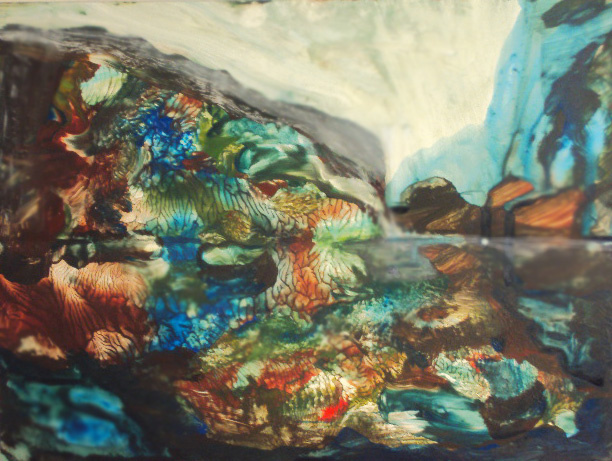
Line Nault, a contemporary dancer and performance artist who works with interactive media and technology, described in detail her project, Non de nom. The title, she told me, means “it’s impossible!” in English, underscoring the role of Buddhism in her life, and understanding the limits of what is possible. She explains her project as “[placing] different tools in the room and my dancers and performers try to find where they are, by different ways of moving, and different technological tools. For example, there is a curtain. And there is white in the back. And they try to cross the wall between the curtains. A lot of concepts in Zen are about how you have an immediate penetration about who you are – it’s like as if the materiality is dissolving. The performers try to cross the wall, but we have a technological system built in so that when they open the curtains, it changes sound, and when they go into it, they are all filmed and it’s going on a screen, but there is a delay in time. They disappear behind the wall, but in the image, they are appearing and disappearing. They also go downstairs from a stairway and hide in a sleeping bag, but on the projections, we see the person nude in a cocoon. It’s all playing on the perception of reversing things from the self, and the materiality of the world we are living in. Are the images we see really who they are? It’s the idea that we have a fascination with our image.”
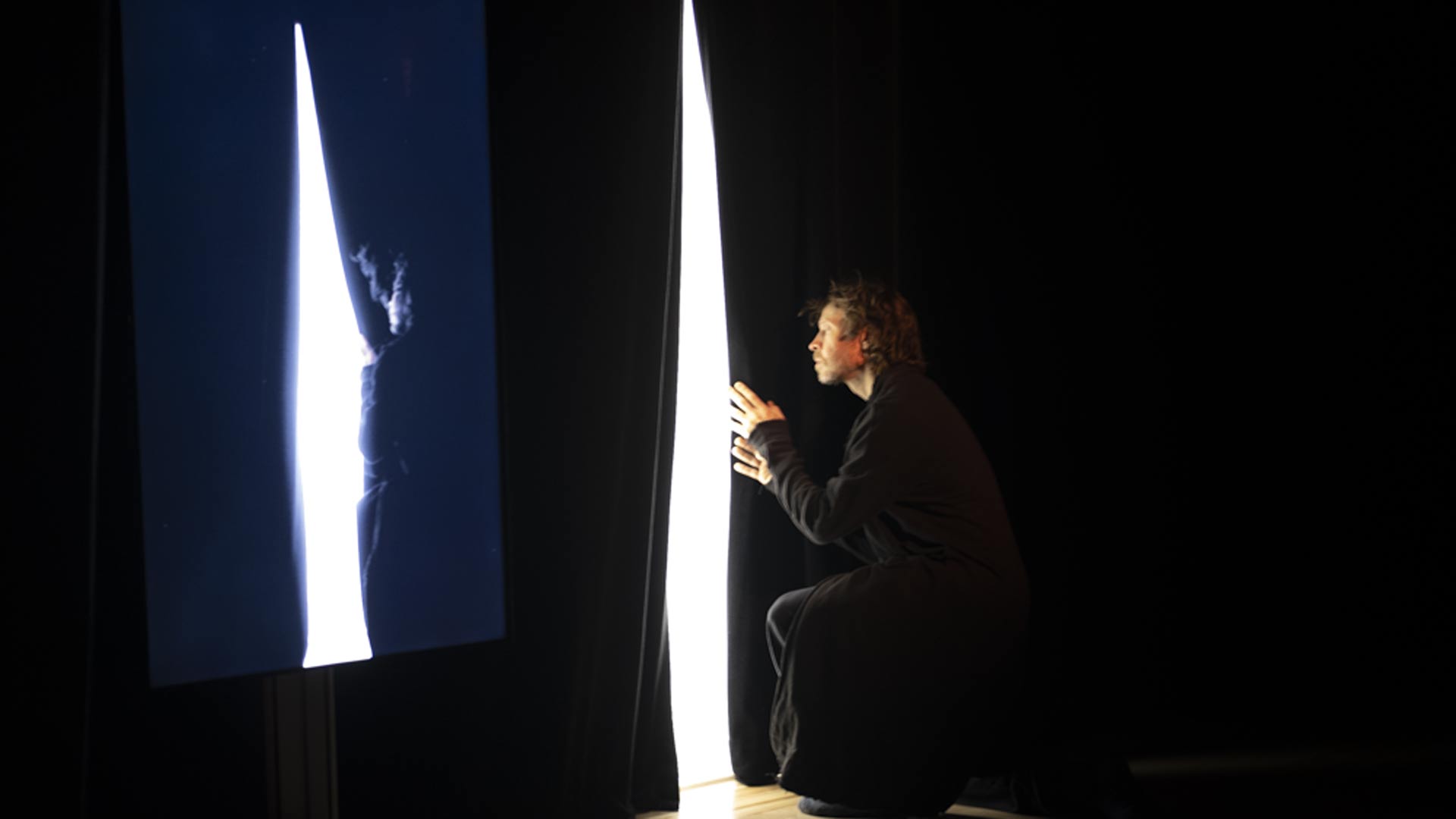
It challenges the question: “Are the images we see really who they are?” As Zen master Albert Low has stated, « le monde que je perçois comprend mes souvenirs, mes désirs, mes craintes, mes illusions et tout le reste. Mais alors, qui, ou quoi, est ce « moi » ? Qui suis-je ? Qui rêve ? » (Low 140). Low was a great influence in Line’s Buddhist practice, and she expressed a desire to have met him before he passed away.
Findings: Interviews – Zen Practice
The second key finding is that Natalie and Line both addressed the “great question” – this is what attracted them to Zen. Natalie suggests that if you repeatedly ask “great questions” in your meditation practice deeply and sincerely: “What is life and death? Where do I go after I die? What is this life all about? What should I be doing? What am I? Who am I? Those big questions in life keep us on the path, I think,” you can eventually get to a, as Zen monk Suzuki puts it, “don’t-know” mind, which is clear like space, a place where your intuition will show you what is true, describing it as “arousing your mind without resting on anything,” which means to be present and not think about anything. This is like the idea of “vast emptiness,” which is having the ability to “[accept] things as they are…[one] can appreciate everything. In everything they do, even though it may be very difficult, they will always be able to dissolve their problems by constancy” (Suzuki 86). They both also described their Zen meditation practices as extremely impactful when they could practice together as a community, and that community played a large role in bringing about the humility in each other since they were required to live, meditate, and work together.
Findings: Interviews – The Personal and the Political
The third key finding is the artists’ purpose. Natalie’s pursuit of Buddhism is motivated by her desire to find purpose in her life after leaving an unhappy marriage. Her suffering led to an existential crisis, which then led her to the Cambridge Zen Center. After years as a practicing resident, she finally found peace and happiness. Line, on the other hand, is motivated by her quest for social and political change. She is a passionate dancer and performance artist, seeking to combine the somatic field, technology, live art, and Zen Buddhism to provoke an awakening in others. She says, “I thought people in Zen could be able to ‘keep it quiet’ and of course, they are trying to help the community because we are alone in our home, but now there is an overload. And when it comes to the media, posting tons of pictures is just pollution. Is it really that interesting for everybody to see your spaghetti, or to see you on the beach? Are you really into living or experiencing when you’re doing that? I think technology is a good tool, but we must choose what we do with it and take our time to digest. It’s good that we can meet like this face-to-face together, but at certain a point, how much overload can I do in a day?” Therefore, Zen Buddhism offers possibilities for peace of mind in both our personal and political lives. This idea also extends also to the digitization of our advanced capitalist society. In an age that is all too dependent on technology, social media and materialism, zazen offers Line and Natalie an alternative.
Findings: Art-Based Autoethnography
In order to move from merely “knowing” the ideas that Line and Natalie talked about, to actually “understanding” them as experience, I embarked on my own experiment of meditation and arts-based inquiry. This meant, first, becoming acquainted with the principles of meditation, and second, to “unlearn” my old ways of doing art. I first learned how to practice zazen, a form of sitting meditation, before making the art. I do not engage in any meditative practice in my daily life, so this was new for me. I practiced sitting upright in lotus position, pressing my diaphragm down and concentrating on inhaling and exhaling. Physically and mentally, I found the meditation sessions difficult. I realized it must take many practices to be able to “sit with painful legs without being disturbed” (Suzuki 41). I “sat” twice for thirty minutes, followed by digital drawing sessions; notes from these sessions were recorded in a journal. I was not surprised that I struggled “to obtain perfect calmness…[one] should not be bothered by the various images in [one’s] mind” (Suzuki 32). I structured my drawing sessions the same way I structured the meditations. Hoping to achieve the emptiness, selflessness, and spontaneity that my interviewees described, I allowed myself only to draw in black and white, and I was not allowed to change my brush strokes or brush size or use any other functions other than drawing. I used no frames of reference, and I could not edit, erase, or reset my artwork if I did not like something. I could not listen to music, check my phone, drink water, or leave to use the bathroom. I had to accept that these challenges would arise because I normally draw as a way of “doing something” instead of “doing nothing.” I had to remain open to ambiguities during the session – I had to let the drawing unravel on its own. After this first session I drew a candle using an electronic drawing tablet (the irony of using technology was not lost on me!).
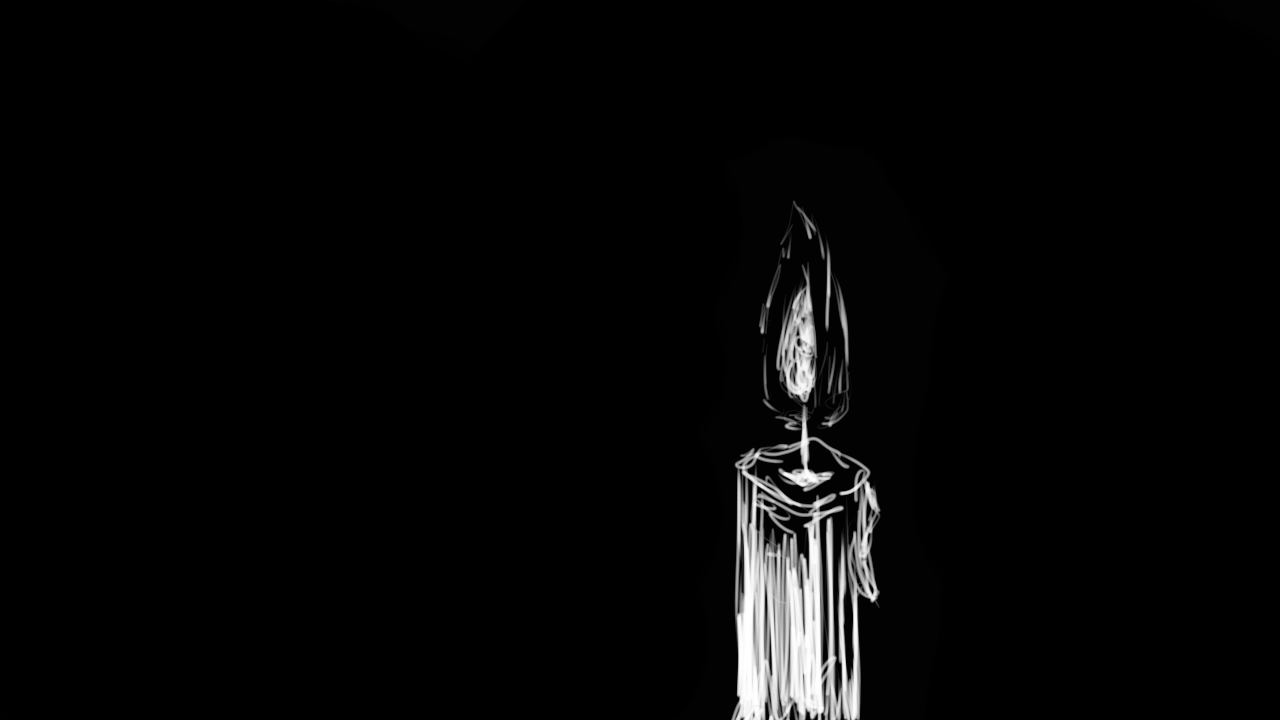
Zen teaches that “if something comes into your mind, let it come in, and let it go out. It will not stay long” (Suzuki 34). Therefore, whatever image appeared on the canvas was spontaneous. I was not as relaxed, I could feel the pressure of my fingers pushing down the pen onto the tablet, I think I was feeling pressure within myself to perform. It was also difficult not being able to listen to music on my headphones. I realized later that I could attach symbolic meaning to the candle or offer a personal interpretation – that it represents the ethereal self that alights in the darkness – but ultimately my drawings were minimalist and entirely “void” of deeper meaning, which is not usually my style. Any intellectual description of the art would be an artificial and a largely inadequate interpretation of the actual experience of drawing the candle. The meaning of this image is not deliberate, an important lesson in our interpretation of art and the meanings that we ascribe to “things.”
After my second session I drew a feather. With the same minimalist character, the brush strokes are light, and there are many of them. I found this session much more enjoyable.
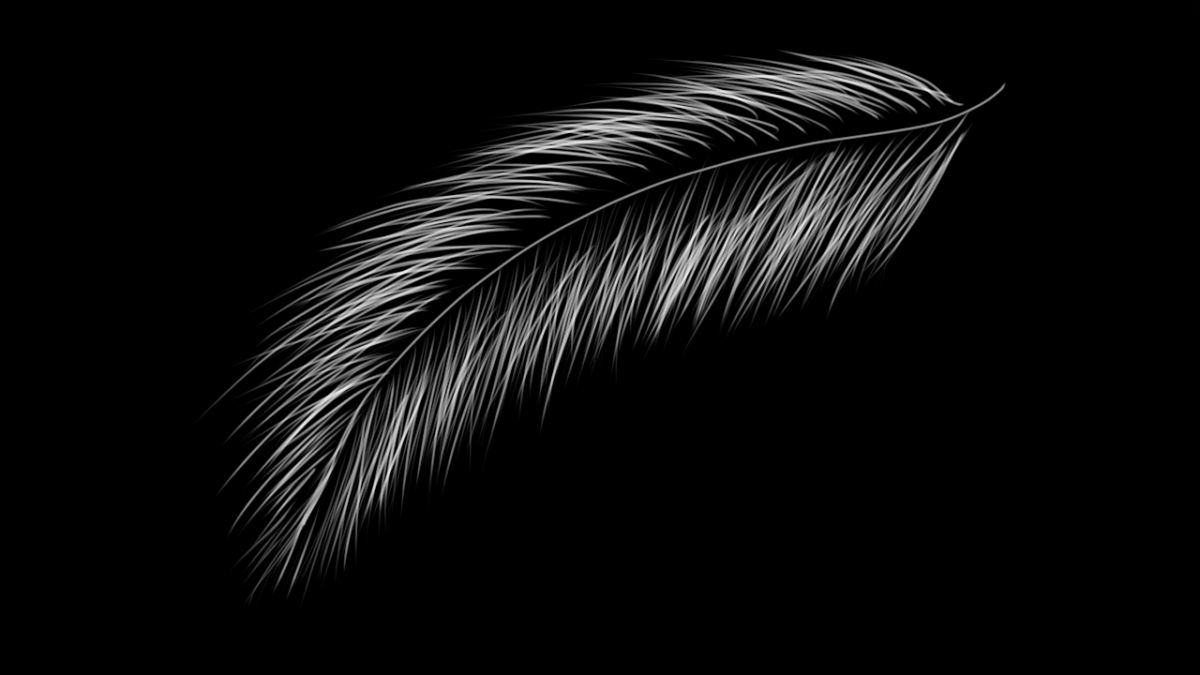
Again, I can offer an “academic” interpretation: the feather represents the joy in that moment and the flight and freedom of the suspended self, but I am not sure that interpretation matters. These were simply images that appeared in my mind. Zen teaches they do not last long, so I drew them. I was surprised that only after two sessions (amounting to only one hour of meditation), I came to rather profound conclusions about the nature of art in general, and about why I do art. Like the questions of self that zazen confronts us with, so too are these questions applicable to art: where does meaning come from?
By contrast, I often paint portraits of real women. These portraits are digitally painted too, except I have access to menus, layouts, interfaces, panels, and various tools to illustrate, modify, adjust, distort, or filter. Also, these paintings are complete, with either a sociological or political perspective.
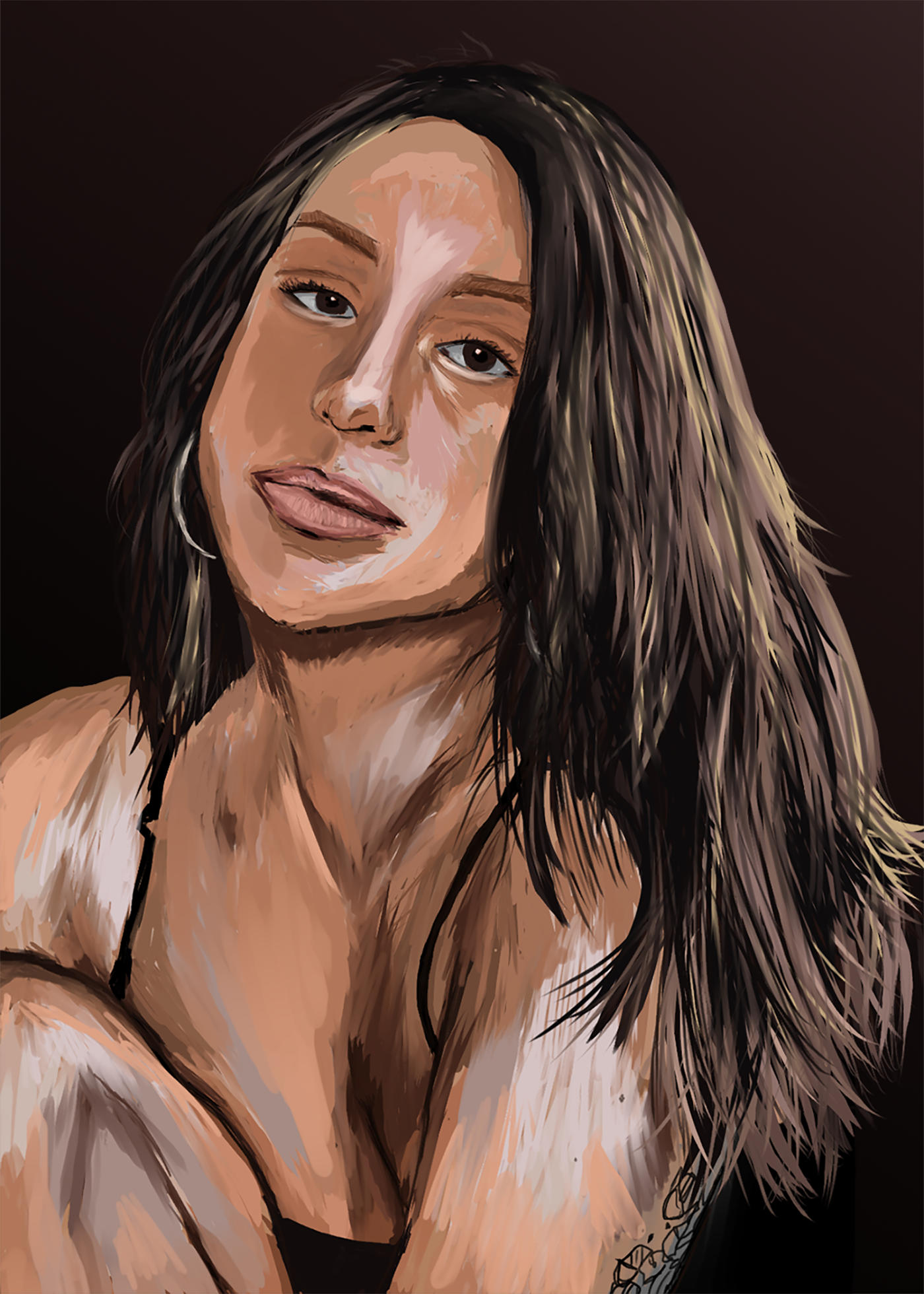
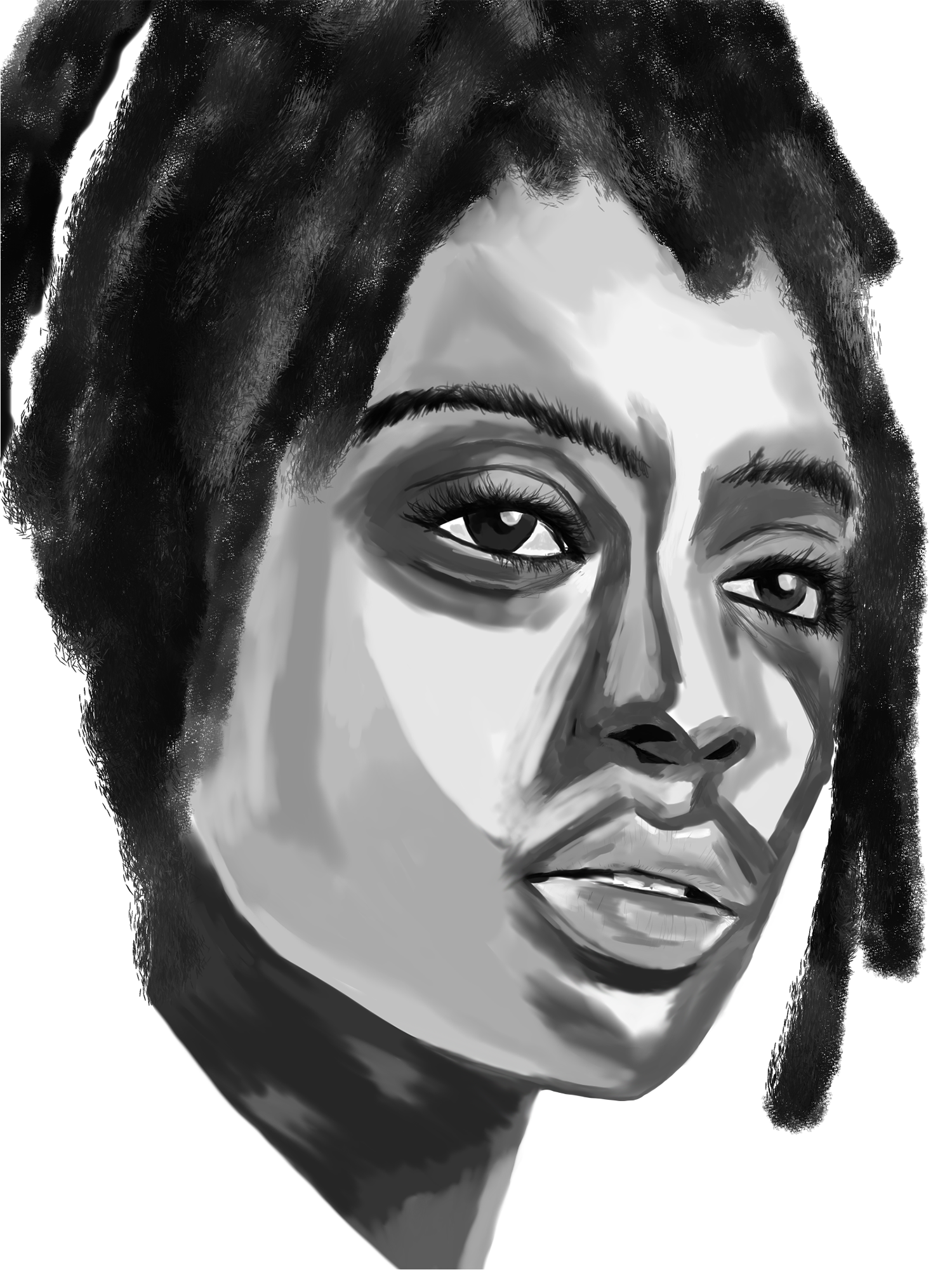
Through this autoethnography, guided by wisdom borrowed from Line and Natalie, I realized that the assumption that I would produce something great as an artist is a symptom of my mind not emptying itself, which is something I always struggle with when making art. Thus, I learned to enjoy the simple physical movements of my hand, and this made me appreciate being alive. I learned how to be comfortable with the unknown, and to privilege the process over the product.
Suggestions for Future Research
In conclusion, since Zen centers are places where people come together to practice as a community – if I had six months instead of six weeks to conduct weekly interviews while participating in a retreat myself, as well as carrying out a collaborative art project as another type of arts-based autoethnography, I could provide more interesting insights to my research questions. In both interviews and my own autoethnographic research, the personal experiences were explored, but Zen has a strong community aspect, thus this could raise another research question: in what way does zazen offer a sense of peace and well-being in a communal way? Finally, our Western society’s fascination with Zen Buddhism could further be explored. Buddhism is reflected not only in Western contemporary art, as discussed in this paper, but has also found its way into popular culture. While Zen concepts and meditative practices are regularly co-opted into the mainstream, and thus risk being emptied of some of their authenticity, even a watered-down version of Buddhism offers an austere contemplation to an often-materialistic society.
Works Cited
Adams, Tony E. et al. Autoethnography. Oxford University Press, 2015.
Blair, Jeremy Michael. “Animated Autoethnographies: Stop Motion Animation as a Tool for Self-Inquiry and Personal Evolution.” Art Education, vol. 67, no. 2, 2014, pp. 6–13.,
Brinkmann, Svend. Qualitative Interviewing. Oxford University Press, 2013.
Low, Albert. « La transmission selon la tradition zen. » Liberté, volume 44, édité et traduit par Jacinthe Dessureault, numéro 3 (257), septembre 2002, p. 135–148.
Plante, Ariane. Photograph of Line Nault’s Non de nom, Agora de la danse, 16 Feb. 2021, www.agoradanse.com/blogue/2021/02/vivarium-technologique.
Suzuki, Shunryu. Zen Mind, Beginner’s Mind. Weatherhill, New York, 1970.
Watson, Natalie. “Peacock.” 2016, www.nataliewatson.org/2016/01/19/art-and-design-blog.


